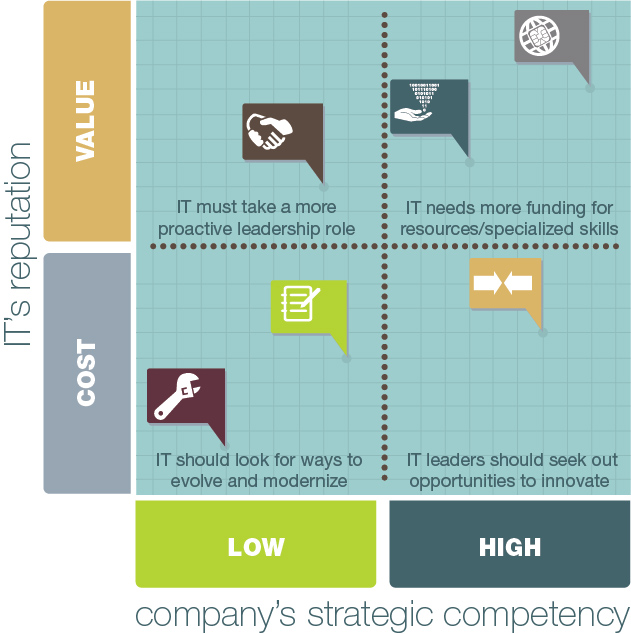
Strategy and Your IT Archetype
IT leaders who put strategy into practice make an IT organization indispensable.
- By Jill Dyché
- November 19, 2019
When I wrote my most recent book, The New IT, the concept of “two-speed IT” (aka: bimodal IT, aka: operational versus strategic IT) was a hot topic in C-suites. Executives bemoaned IT departments they believed focused too heavily on feeds and speeds, platforms, and emerging tech prototypes, all but ignoring what the business needed.
Trouble was, these were the very executives who were establishing IT success measures. Even today, company managers inspect measurements like system uptime, budget containment, and defect rates to gauge IT’s effectiveness. Frustrated CIOs push back. Why doesn’t the CEO understand technology’s role in sales growth, prospect conversion rates, product enhancements, and innovation?
As IT struggles to prove its strategic value, questions such as this one continue:
Dear Jill,
I am a vice president of application development at a growing retail software start-up. I’ve recently been asked by my boss, the company’s COO, to define my team’s value measures. I’m not sure whether this is because he doesn’t know how to define them, or because he thinks he might be missing something.
Development, and IT in general, have been commoditized at my company, which is ironic since we depend so heavily on technology advancements to sell our products. I’m not sure what I should be measured on, but it seems to be how quickly we can get new functionality out the door. There’s nothing wrong with that when you’re a start-up, but this all masks other value we’re creating.
It strikes me that we need to map where we are to where we want to be. Do you have any guidance?
-- Thank you in advance, Darren
To be honest, I’ve always been conflicted about the two-speed IT rubric. On the one hand, it’s simple enough to bifurcate the two operating models and call out their behaviors. One is tactical and performance-based, the other is more forward-thinking. One focuses on avoiding backsliding, the other on innovating for the future. One runs the business, the other focuses on enabling the future.
Of course, most IT managers would claim that their organizations have characteristics of both speeds, so it’s a matter of where your company is on that continuum and, more important, what your company values.
The problem is that no IT department can divorce itself from the company’s culture. To quote the well-worn Peter Drucker maxim, “Culture eats strategy for breakfast.”
That’s why -- after interviewing over a dozen leaders for The New IT -- I further deconstructed the “two-speeds” into six different IT archetypes. These archetypes define not only how IT behaves, but how it is seen by its constituents. Briefly, the archetypes are:
Tactical. Tactical IT focuses on operational fulfillment, ensuring that systems are buzzing and business users are happy. In the tactical model, service-level agreements are doctrine, uptime is king, and the word “modernization” is only uttered in whispers.
Order taking. In seeking to satisfy cross-functional business needs, order-taking IT departments excel at project planning. Managers spend time refining requirements-gathering processes and polishing functional specs. Getting headcount is a constant challenge as leaders juggle supply and demand.
Aligning. IT teams characterized as aligning focus on meeting the needs of heterogeneous business units, often by designating business architects or business-IT liaisons. These teams excel at project prioritization, often struggling to satisfy the competing needs of multiple and diverse constituents.
Data provisioning. IT departments focused on data provisioning have seen the writing on the wall. With data being “the new oil,” (or “the new water” or “the new air”), the IT team that manages and deploys information between and across business units has immediate authority and a new level of prestige.
Brokering. Brokering IT departments understand the concept of playing to their strengths by delivering what they’re skilled at and developing a network of partners for more specialized work or cost-effective solutions. The cloud looms large for these teams, but it’s only one of many delivery methods in this model.
IT everywhere. The IT everywhere archetype means that IT is considered woven into business strategy and operations. Technology ownership is shifted to those who use it, and the IT teams will often move directly into lines of business. Increasingly IT plays the role of program management and procurement, choreographing project delivery, minimizing duplicate efforts, maintaining an enterprise-level road map, and functioning as an authoritative reporting body.
It’s important to note that this isn’t a maturity model as much as it is a point-in-time recognition of the IT zeitgeist in your company, and it has everything to do with leadership.
It’s also important -- and this might have occurred to you already -- that none of these archetypes is pure and that others factor in. A common example is the CIO who acknowledges being pigeonholed as “tactical” while she is cultivating a culture of more widespread technology ownership within lines of business, moving her organization further toward an aligning model.
Since we’re on TDWI’s Upside site here, I’m compelled to add that analytics is a perfect set of disciplines for IT and business departments to effectively share, helping a CIO evolve the department. After all, a rising tide lifts all boats. (I’m not sure who said that but we can rule out Peter Drucker.)
Make no mistake: there’s a correlation between IT’s existing archetype and its strategic competency. In doing my research for the book, I also found a high correlation between strategic rigor and a planning culture inclusive of IT leadership. The following figure shows how the archetypes map:

Republished with permission of McGraw-Hill Education, from The New IT: How Technology Leaders Are Enabling Business in the Digital Age by Jill Dyché, 2015; permission conveyed through Copyright Clearance Center, Inc.
As I say in the book, moving from one archetype to another usually means evolution, not revolution. This kind of progress involves incremental changes and support from key allies and partner organizations who have collaborated with IT and have positive outcomes to share.
The hard part, as Darren suggests, is convincing leadership to support the changes. There’s also a correlation there: show me a leader who understands putting strategy into practice and I’ll show you an IT organization that’s considered indispensable!
About the Author
Jill Dyché has advised clients and executive teams on their analytics and data programs for as long as she can remember. Longer, in fact. She’s the author of four books on the business value of technology and regularly talks to teams about what keeps them up at night. Ambivalent about analytics? Maddened by management? Constricted by your culture? Check out Jill’s Q&A column, Q&A with Jill Dyché, here.